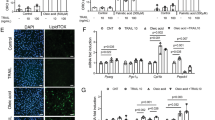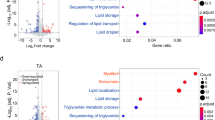Abstract
Background:
It has been well documented that human adenovirus type 36 (Ad-36) is associated with obesity. However, the underlying molecular mechanism of Ad-36 inducing obesity remains unknown. We sought to investigate the effect of Ad-36 infection on Cidec, AMPK pathway and lipid metabolism in primary cultured human skeletal muscle cells.
Methods:
Cidec/fat-specific protein 27 (FSP27), fatty acid oxidation, AMPK signaling and the abundance of proteins involved in lipid synthesis were determined in muscle cells infected with various doses (1.9–7.6 MOI) of Ad-36 and non-lipogenic adenovirus type 2 (Ad-2) as a negative control as well as an uninfected control. Cidec/FSP27 siRNA transfection was performed in Ad-36-infected muscle cells.
Results:
Our data show that Ad-36 significantly reduced fatty acid oxidation in a dose-dependent manner (all P values are <0.01), but Ad-2 did not affect fatty acid oxidation. Ad-36 substantially increased Cidec/FSP27, ACC, sterol regulatory element-binding protein 1c (SREBP-1c), SREBP-2 and 3-hydroxy-3-methylglutaryl-CoA reductase protein abundance, but significantly reduced AMPK activity, mitochondrial mass and uncoupling protein 3 (UCP3) abundance in comparison with control cells (all P values are <0.01). Oil Red O staining revealed that there was substantial fat accumulation in the Ad-36-infected muscle cells. Furthermore, Cidec/FSP27 siRNA transfection significantly reduced FSP27 expression and partially restored AMPK signaling, increased UCP3 and decreased SERBP 1c and perilipin proteins in Ad-36-infected muscle cells. Interestingly, neither Ad-36 nor Ad-2 affected peroxisome proliferator-activated receptor γ protein expression in muscle cells.
Conclusion:
This study suggests that Ad-36 induced lipid droplets in the cultured skeletal muscle cells and this process may be mediated by promoting Cidec/FSP27 expression.
This is a preview of subscription content, access via your institution
Access options
Subscribe to this journal
Receive 12 print issues and online access
$259.00 per year
only $21.58 per issue
Buy this article
- Purchase on Springer Link
- Instant access to full article PDF
Prices may be subject to local taxes which are calculated during checkout








Similar content being viewed by others
Abbreviations
- SREBP-1c:
-
sterol regulatory element-binding protein 1c
- HMGR:
-
3-hydroxy-3-methylglutaryl-CoA reductase
- UCP3:
-
uncoupling protein 3.
References
Van Ginneken V, Sitnyakowsky L, Jeffery JE . Infectobesity: viral infections (especially with human adenovirus-36: Ad-36) may be a cause of obesity. Med Hypotheses 2009; 72: 383–388.
Dhurandhar N, Atkinson R, Ahmed A . Obesity of infectious origin–a review. Growth Genet Horm 2004; 20: 33–39.
Whigham LD, Israel BA, Atkinson RL . Adipogenic potential of multiple human adenovirus in vivo and in vitro in animals. Am J Physiol Regul Inter Comp Physiol 2006; 290: R190–R194.
Rogers PM, Fusinski KA, Rathod MA, Loiler SA, Pasarica M, Shaw MK et al. Human adenovirus Ad-36 induces adipogenesis via its E4 orf-1 gene. Int J Obes (Lond) 2008; 32: 397–406.
Greenway F . Virus-induced obesity. Am J Physiol Regul Integr Comp Physiol 2006; 290: R188–R189.
Vangipuram SD, Sheele J, Atkinson RL, Holland TC, Dhurandhar NV . A human adenovirus enhances preadipocyte differentiation. Obes Res 2004; 12: 770–777.
Atkinson RL, Dhurandhar NV, Allison DB, Bowen RL, Israel BA, Albu JB et al. Human adenovirus-36 is associated with increased body weight and paradoxical reduction of serum lipids. Int J Obes (Lond) 2005; 29: 281–286.
Schutz Y, Flatt JP, Jequier E . Failure of dietary intake to promote fat oxidation: a factor favoring the development of obesity. Am J Clin Nutr 1989; 50: 307–314.
Dauncey MJ, Gilmour RS . Regulatory factors in the control of muscle development. Proc Nutr Soc 1996; 55: 543–559.
Pan DA, Lillioja S, Kriketos AD, Milner MR, Baur LA, Bogardus C et al. Skeletal muscle triglyceride levels are inversely related to insulin action. Diabetes 1997; 46: 983–988.
Boden G . Interaction between free fatty acids and glucose metabolism. Curr Opin Clin Nutr Metab Care 2002; 5: 545–549.
Keller P, Petrie JT, Rose PD, Gerin I, Wright WS, Chiang S-H et al. Fat-specific protein 27 regulates storage of triacylglycerol. J Biol Chem 2008; 283: 14355–14365.
Liang L, Zhao M, Xu Z, Yokoyama KK, Li T . Molecular cloning and characterization of CIDE-3, a novel member of the cell-death-inducing DNA-fragmentation-factor (DFF45)-like effector family. Biochem J 2003; 370: 195–203.
Nishino N, Tamori Y, Tateya S, Kawaguchi T, Shibakusa T, Mizunoya W et al. FSP27 contributes to efficient energy storage in murine white adipocytes by promoting the formation of unilocular lipid droplets. J Clin Invest 2008; 118: 2808–2821.
Keller P, Petrie JT, De Rose P, Gerin I, Wright WS, Chiang SH et al. Fat-specific protein 27 regulates storage of triacylglycerol. J Biol Chem 2008; 283: 14355–14365.
Puri V, Virbasius JV, Guilherme A, Czech MP . RNAi screens reveal novel metabolic regulatos: RIP140, MAP4k4 and the lipid droplet associated fat specific protein (FSP) 27. Acta Physiol (Oxf) 2008; 192: 103–115.
Qi J, Gong J, Zhao T, Zhao J, Lam P, Ye J et al. Downregulation of AMP-activated protein kinase by Cidea-mediated ubiquitination and degradation in brown adipose tissue. EMBO J 2008; 27: 1537–1548.
Greenberg AS, Egan JJ, Wek SA, Garty NB, Blanchette-Mackie EJ, Londos C . June Perilipin, a major hormonally regulated adipocyte-specific phosphoprotein associated with the periphery of lipid storage droplets. J Biol Chem 1991; 266: 11341–11346.
Puri V, Konda S, Ranjit S, Aouadi M, Chawla A, Chouinard M et al. Fat specific protein 27: a novel lipid droplet protein that enhances triglyceride storage. J Biol Chem 2007; 282: 34213–34218.
Puri V, Ranjit S, Konda S, Nicoloro SMC, Straubhaar J, Chawla A et al. Cidea is associated with lipid droplets and insulin sensitivity in humans. Proc Natl Acad Sci USA 2008; 105: 7833–7838.
Wang ZQ, Cefalu WT, Zhang XH, Yu Y, Qin J, Son L et al. Human adenovirus type 36 enhances glucose uptake in diabetic and nondiabetic human skeletal muscle cells independent of insulin signaling. Diabetes 2008; 57: 1805–1813.
Wang ZQ, Bell-Farrow AD, Sonntag WE, Cefalu WT . Effect of age and caloric restriction on insulin receptor binding and glucose transporter levels in aging rats. Exp Gerontology 1997; 32: 671–684.
Pendergrass W, Wolf N, Poot M . Efficacy of MitoTracker Green and CMXrosamine to measure changes in mitochondrial membrane potentials in living cells and tissues. Cytometry 2004; A61: 162–169.
Hulver MW, Berggren JR, Cortright RN . Skeletal muscle lipid metabolism with obesity. Am J Physiol Endocrinol Metab 2003; 284: E741–E747.
Carling D . The AMP-activated protein kinase cascade—a unifying system for energy control. Trends Biochem Sci 2004; 29: 18–24.
Osler ME, Zierath JR . Minireview: adenosine 5′-monophosphate-activated protein kinase regulation of fatty acid oxidation in skeletal muscle. Endocrinology 2008; 149: 935.
Gong J, Sun Z, Li P . CIDE proteins and metabolic disorders. Curr Opin Lipidol 2009; 20: 121–126.
Keller P, Petrie JT, De Rose P, Gerin I, Wright WS, Chiang SH et al. Fat-specific protein 27 regulates storage of triacylglycerol. J Biol Chem 2008; 283: 14355–14365.
Be'zaire V, Seifert EL, Harper M-E . Uncoupling protein-3: clues in an ongoing mitochondrial mystery. FASEB J 2007; 21: 312–324.
Tarling E, Salter A, Bennett A . Transcriptional regulation of human SREBP-1c (sterol-regulatory-element-binding protein-1c): a key regulator of lipogenesis. Biochem Biochem Soc Trans 2004; 32 (Part 1): 107–109.
Wong J, Quinn CM, Brown AJ . SREBP-2 positively regulates transcription of the cholesterol efflux gene, ABCA1, by generating oxysterol ligands for LXR. Biochem J 2006; 400: 485–491.
Pai JT, Guryev O, Brown MS, Goldstein JL . Differential stimulation of cholesterol and unsaturated fatty acid biosynthesis in cells expressing individual nuclear sterol regulatory element-binding proteins. J Biol Chem 1998; 273: 26138–26148.
Shimano H . SREBPs: physiology and pathophysiology of the SREBP family. FEBS J 2009; 276: 616–621.
Horton JD, Shimomura I, Brown MS, Hammer RE, Goldstein JL, Shimano H . Activation of cholesterol synthesis in preference to fatty acid synthesis in liver and adipose tissue of transgenic mice overproducing sterol regulatory element-binding protein-2. J Clin Invest 1998; 101: 2331–2339.
Guillet-Deniau I, Pichard AL, Koné A, Esnous C, Nieruchalski M, Girard J et al. Glucose induces de novo lipogenesis in rat muscle satellite cells through a sterol-regulatory-element-binding-protein-1c-dependent pathway. J Cell Sci 2004; 117 (Part 10): 1937–1944.
Brown MS, Goldstein JL . The SREBP pathway: regulation of cholesterol metabolism by proteolysis of a membrane-bound transcription factor. Cell 1997; 89: 331–340.
Guan G, Dai P, Shechter I . Differential transcriptional regulation of the human squalene synthase gene by sterol regulatory element-binding proteins (SREBP) 1a and 2 and involvement of 5′ DNA sequence elements in the regulation. J Biol Chem 1998; 273: 12526–12535.
Yang J, Craddock L, Hong S, Liu ZM . AMP-activated protein kinase suppresses LXR-dependent sterol regulatory element-binding protein-1c transcription in rat hepatoma McA-RH7777 cells. J Cell Biochem 2009; 106: 414–426.
Acknowledgements
We thank Dr Nikhil Dhurandhar for kindly providing adenovirus 2 and adenovirus 36. This project used facilities that are supported in part by COBRE (NIH P20-RR021945) and CNRU (NIH 1P30-DK072476) center grants from the National Institutes of Health.
Author information
Authors and Affiliations
Corresponding author
Ethics declarations
Competing interests
The authors declare no conflict of interest.
Rights and permissions
About this article
Cite this article
Wang, Z., Yu, Y., Zhang, X. et al. Human adenovirus 36 decreases fatty acid oxidation and increases de novo lipogenesis in primary cultured human skeletal muscle cells by promoting Cidec/FSP27 expression. Int J Obes 34, 1355–1364 (2010). https://doi.org/10.1038/ijo.2010.77
Received:
Revised:
Accepted:
Published:
Issue Date:
DOI: https://doi.org/10.1038/ijo.2010.77
Keywords
This article is cited by
-
Evaluation of vital genes correlated with CD8 + T cell infiltration as prognostic biomarkers in stomach adenocarcinoma
BMC Gastroenterology (2023)
-
Inhibition of AMP-activated protein kinase in respiratory syncytial virus infection activates lipid metabolism
Archives of Virology (2021)
-
What we know and what we need to know about adenovirus 36-induced obesity
International Journal of Obesity (2020)
-
Multi-etiological Perspective on Child Obesity Prevention
Current Nutrition Reports (2019)
-
CIDEC Is Involved in LPS-Induced Inflammation and Apoptosis in Renal Tubular Epithelial Cells
Inflammation (2018)



